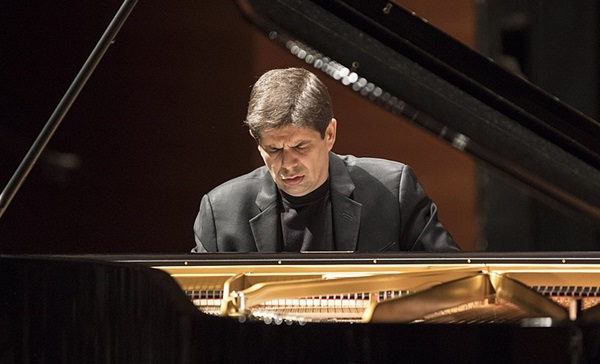 Canada Various: Javier Perianes (piano). Vancouver Playhouse, Vancouver, 11.2.2024. (GN)
Canada Various: Javier Perianes (piano). Vancouver Playhouse, Vancouver, 11.2.2024. (GN)

Clara Schumann – Variations on a Theme by Robert Schumann, Op.20
Robert Schumann – Sonata No.3 in F minor, Op.14 – Part III: Andantino de Clara Wieck
Brahms – Variations on a Theme by Robert Schumann, Op.9
Granados – Goyescas, Op.11
It is always a special occasion when Enrique Granados’s Goyescas appears on a recital program. Along with Albeniz’s Iberia, it is one of the greatest Spanish piano compositions of the twentieth century. It is also a tremendous challenge for any pianist – it is written in six movements and runs more than 50 minutes. Javier Perianes has delighted us in the Spanish repertoire before, and he has all the credentials for the undertaking, including a rich and beautiful tone and estimable agility. He has just recorded this work for Harmonia Mundi.
His performance was perhaps bolder and more direct than one is used to, but it still added up to an enriching tour-de-force, less lyrically penetrating but possibly finding a greater weight and reach in the work’s overall concept. The first part of the program was very different but also instructive, comparing the efforts of Clara Schumann and Brahms to write variations on the same Robert Schumann theme.
Any discussion of Goyescas inevitably must start with Alicia de Larrocha, whose interpretations have always been a reference and who found wonderful elegance, balance and a sense of completeness. Most notable are her integrative flow and subtleties of phrase and rhythm which spawned countless moments of delicacy and charm and revealed both the improvisatory and melancholic dimensions in Francisco Goya’s expression.
If de Larrocha’s presentation exudes a clear ‘personal’ component, Perianes seemed more interested in building the piece in objective blocks and exposing structural components. Rather than overtly stressing flow and lyrical colour, Perianes highlighted the composer’s fertile imagination in musical construction and timbre, his evident playfulness, his occasional flirtation with extremes and the juxtaposition of such constructions within a piece. These were coupled with moments of great energy.
There was a freshness to this approach, and it featured playing of both precision and beauty. The ‘core’ movements of the work (I to IV) exhibited fine detailing and a cultivated rhythmic sense, but some things still did not seem exactly right. The opening jota (an eighteenth century Aragonese dance) was taken with an almost frenzied passion (faster than his recording), which slightly upset the balance in I and limited its charm. The powerful fandango in III was astute rhythmically, but the overall result seemed plain. In the famous Girl and the Nightingale nocturne in IV, Perianes was certainly able to enter the spirit of the piece and mine some interesting emotional corners, yet it was not evocative enough and, at times, lacked a natural continuity, possibly because the rubato line was not set broadly.
It was in the long fifth movement, El amor y la muerte (Love and death), that the pianist’s approach paid real dividends. After the imposing dark notes with which it begins, Perianes sustained a wonderful concentration throughout. The telling point for me was when we arrived at the softest utterances in the movement, which are normally taken to convey a deep personal sadness and regret. But here the feeling was different: the murmurings somehow conveyed a sense of wonder, of timelessness, as in Beethoven’s final sonatas. There was something more here than just ‘personal’: there was something more universal, like the universal reach and timelessness in Goya’s art.
The ‘big picture’ was completed in the epilogue. After the striking rhythmic figure at the opening, Perianes was able to convey a sense of homage to the painter, building the piece in a gradual flow through recognizable constructions from earlier in the work. There was wonderful nostalgia here and a true sense of inevitability which created almost a cinematic pageant to this great artist. Of course, given Granados’s sense of play/macabre, with the flick of the closing ascending notes, it all vanishes into the ether. A rich and consuming experience all told and I have not heard a performance of Goyescas quite as reverential as this.
The first part of the concert involved quite a different repertoire, showcasing the efforts of both Clara Schumann and Brahms to write variations on a theme by Robert Schumann. Both compositions date from the mid-1850s, the troubling time when Robert Schumann’s mental faculties had declined so much that he had to be placed in a sanitorium. Many of the variations are tinged with obvious regret and sadness and juxtaposed with more robust and encouraging expressions. In fact, Brahms went out of his way to incorporate Schumannesque constructions, including his characteristic ‘Florestan and Eusebius’ design.
Perianes showed poise and judgement here, conveying considerable feeling and, when needed, fire. His rich burnished tone suited the Brahms perfectly. Clara Schumann’s variations had a certain poignancy to them but, as is to be expected, they pale when set beside the sophistication of the Brahms. Nonetheless, the experiment was instructive and involving, as was the whole recital.
A scintillating rendering of Manuel de Falla’s Ritual Fire Dance provided the nightcap.
Geoffrey Newman
